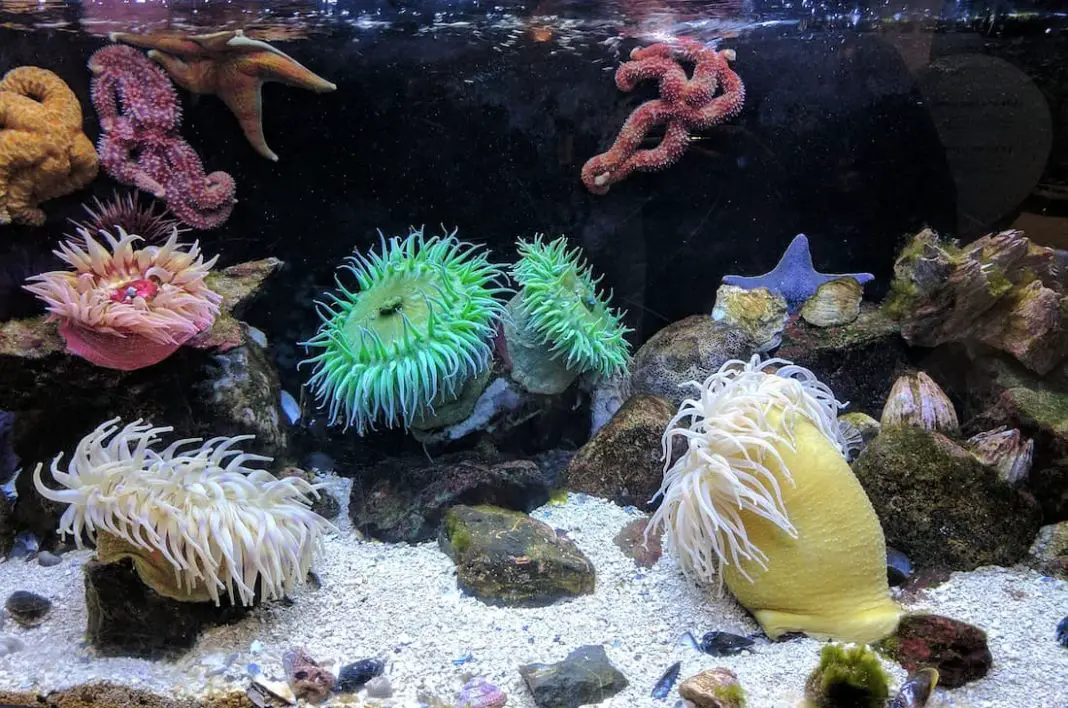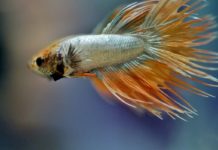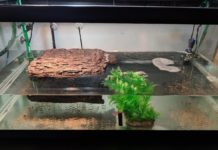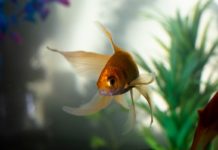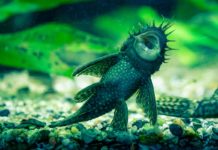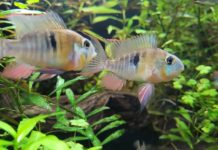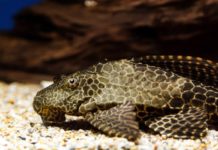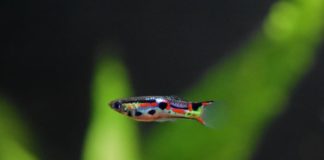Quicklinks
- Sailfin Tang With Ich? What Is It?
- Signs That A Sailfin Tang Has Ich
- Treating A Sailfin Tang With Ich
- What Is Known About Saltwater Ich
- The Water Change Method To Treat Saltwater Ich
- Treating Ich With Hyposalinity
- The Pulsing Method
- The Transfer Method
Sailfin Tang With Ich? What Is It?
Ich is a very common saltwater fish disease caused by an external parasite. Once a sailfin tang is infested with ich, it will develop white cysts which look like small salt like grains on its skin, gins, and even inside the gills.
Unfortunately, ich is pretty tricky to treat once it has gotten inside an aquarium and has made itself loose there. Ich goes through many life cycles, and recurrent infections are always within the bounds of possibility.
In order to fully get rid of saltwater ich, it’s vital to first understand its life cycle first. Otherwise, any treatment that’s introduced will simply be a shot in the dark.
Before getting into the different life stages, let’s look at the most common signs of saltwater ich on a sailfin tang.
Signs That A Sailfin Tang Has Ich
The universal sign of ich in a sailfin tang, or any other fish for that matter, is the appearance of tiny white dots across the body – tail, fins, gills. The unfortunate part is that your sailfin tang will probably look fine, not acting sickly until the Ich parasite has completed a few lifecycles.
Depending on the tank’s water parameters, it can take anywhere from a few days to a few weeks.
Once you’ve realised that your tang has gotten ich, it’s important to watch closely for any signs of an anomaly if your fish isn’t acting like itself lately.
Symptoms of saltwater ich in a sailfin tang:
- Tiny salt grain like white spots
- Scratching its body against rocks
- Bruises and loss of scales
- Problem breathing
- Lethargy
- Loss of appetite
- Erratic swimming patterns
- Change in scale or skin color
- Increased mucus production
- Staying still either at the surface or bottom
The good news is that a healthy sailfin tang can stave off its effects without batting an eye. However, if the sailfin tang is stressed and its immune system is compromised, ich will quickly make its way into the sailfin tang body.
If your sailfin tang is showing any of the signs mentioned above alongside white spots, then you should err on the side of caution.
Now, let’s have a quick look at the lifecycle of saltwater ich.
Understanding The Life Cycle Of Saltwater Ich
A saltwater ich’s life cycle comprises 4 different stages in which the parasite takes on 5 unique forms.
The five forms are:
- Trophont
- Protomont
- Tomont
- Tomite
- Theront
The four stages are:
- Infection
- Feeding
- Drop-off
- Reproduction
Due to the parasites’ rather complex life cycle, getting rid of it can be unpredictable. It’s important to remember that the parasite is only vulnerable to treatment when it’s in the free-swimming stage.
Therefore, if the parasite doesn’t reach this stage before the end of the treatment, the treatment may go to waste, yet again reinfecting the sailfin tang.
When you’re dealing with a closed system like a tank, the parasite can quickly reach overwhelming and disastrous numbers if not diagnosed and treated on time.
Trophont
At this stage, the parasite manifests as tiny white dots on the infected sailfin tang. The trophonts will burrow deep into the tang’s skin and consume the flesh until it has fed enough to move on to the next stage of its lifecycle.
Protomont
After around 2-10 days of feeding on the tang, the trophont will fall off and lie on the base of the tank as it prepares for its next stage.
Tomont
At this stage, the parasite is embedded in the substrate, which has to happen within 8 hours of falling, the parasite is called tomont. During this stage, the parasite will divide itself, producing up to 1000 child cells known as tomites.
Tomites are released in the final stage of the saltwater parasite.
At this stage, many hobbyists can be fooled into thinking that they have eliminated the ich. However, the parasite can live on the substrate for up to 72 days with no signs of infection on your sailfin tang.
Theront
The released child cells become free-swimming and survive for around 8 hours in the tank. During this time, it will actively look for any fish to latch on to in an attempt to reignite the parasite’s lifecycle.
Now that you have a better understanding of saltwater ich’s lifecycle, let’s look at some effective treatment techniques.
Treating A Sailfin Tang With Ich
The traditional advice has been to quarantine all of your new arrivals for 28-30 days before adding fish to the display tank, to prevent any possible transfer of the parasite into your display.
Although this advice certainly serves as a good start and is arguably more than what most people do, let’s dive deeper into the science and determine how sound this advice actually is.
The rationale for this often-cited time frame of around 28-30 days is that the entire lifespan of saltwater ich begins and ends within the 28-day period. This means that the parasite is born, finds a host (parasite infects your fish), reproduces, and dies all within that time frame, starting the circle of life all over again.
The theory goes that if you can avoid affecting any of the fish (eg. leave your fish in quarantine, under treatment for that period), you can add them to your tank relatively risk-free.
What Is Known About Saltwater Ich
The best way to protect a sailfin tang and the rest of the reef aquarium is to prevent it in the first place. Prevention means keeping any potential ich-infested fish out of the aquarium. This is typically done using a quarantine tank. The idea behind quarantine is to isolate any new fish, observing it for a few weeks, although ideally one month, to make sure the fish is healthy. A quarantine tank can be as simple as a ten or twenty-gallon tank with a heater and filter. If it’s carrying ick, the fish will probably show signs during the quarantine period. If it does, the quarantine tank helps to keep from infesting the main display tank but also provides a small, safe location to treat the tang.
Here are several ways to treat ich when the fish are in the quarantine tank.
The Water Change Method To Treat Saltwater Ich
The first method involves making 50% water changes every day for two weeks while paying careful attention and siphoning off anything lying at the bottom of the tank. This means that the tank must be bare at the bottom.
The reason for siphoning the bottom of the tank is because the protomonts fall to the bottom of the tank and become tomonts. The idea is that since you’re vacuuming up the bottom of the tank, every day, you should (in theory) be able to remove all the tomonts/cysts before they become problematic.
Of course, as a single parasite can explode into many copies of itself in a short period of time, this method certainly does have an Achilles heel. It’s important to note that if you miss even a few, you mightn’t eradicate the problem.
Treating Ich With Hyposalinity
Hyposalinity is another non-chemical treatment for saltwater ich. One of the forces of chemistry that every fish must face is called osmotic pressure. Osmotic pressure is the principle behind reverse osmosis water purification in your RO/DI filter (if you have one). This is done by employing osmosis to destroy saltwater ich by lowering the salinity of the water to a level that is close to freshwater (close, but not quite).
Note: Although this method can be useful, you need to remember that you should only do this with hardy marine fish species, not with any invertebrates at all.
Hyposalinity is a popular way to treat saltwater ich—it’s used as it doesn’t involve any tricky chemicals and it can be monitored with the same equipment you already have — a hydrometer or refractometer.
The Pulsing Method
The pulsing method of saltwater ich is to dilute the water in your quarantine tank by 5% every hour down to 10% seawater strength.
Once you’ve reached 10% strength, hold the salinity there for around 3 hours, then reverse it back 5% per hour until you return to full-strength seawater.
It’s recommended to repeat this process every three days (dropping to hyposalinity for 3 hours on days 1, 4, 7, 10).
The Transfer Method
Using the transfer method is still one of the oldest but one of the best ways to treat saltwater ich.
The basic premise of the transfer method is that you move the infected sailfin tang to a clean, disinfected tank every few days. After moving the tang, clean and dry the old tank, removing any cysts and, after a few more days, move the tang back to the main tank. When you do this, the parasites that fall off the sailfin tang never get a chance to reproduce and reattach to the tang, so after a few cycles of doing this, all the parasites should fall off and get removed, therefore the tang will have been cured.
Preventing Saltwater Ich On Your Sailfin Tang In The Future:
- When introducing a new species always quarantine them for 45 to 90 days
- Never share equipment between aquariums before properly sanitizing and sterilizing them
- Keep the quarantine tank at least 10 feet away from the display tank
- Always maintain the best water parameters and tank maintenance
- Never add water from the travel pouch in your aquarium

